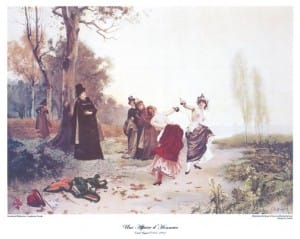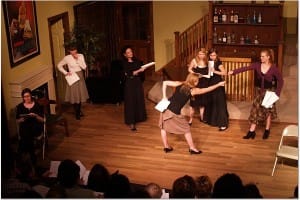Decent all-women plays are scarce. I wrote “The Knitting Circle” as a short bravura piece for six talented actresses. My intention was to let women conduct stage combat and operatic violence, which is, even in our supposedly enlightened age, reserved almost entirely for male actors. Additionally, I hoped that the characters and their conflicts would be more rounded than the agonizingly common slut/virgin female stereotypes.
The only really good all-female drama I have ever read is “The House of Bernarda Alba” by Federico Garc?a Lorca. (The play is readable in the original, even for us polyglot dummies who studied Spanish for only a few years.) Thus I have lifted Lorca’s structure of a tragic matriarch, torn by anti-male sentiment, grasping for control of her rebellious brood.
Here’s a lithograph of the original picture, “Une Affaire d’honneur,” by Emile Bayard, that inspired the script:
And here’s the opening tableau from the staged read:

